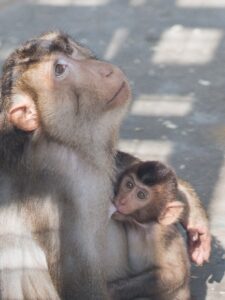
The Behavioral Management Program oversees environmental enrichment of laboratory monkeys at the Washington National Primate Research Center (WaNPRC)
In 1991, the USDA developed Animal Welfare Standards in response to the 1985 AWA amendment. These standards require research institutions, zoos, and other facilities with captive nonhuman primates to formulate Environmental Enhancement Plans to enrich the primates’ physical environment and address their social needs. Although the USDA provides guidelines as to the necessary content of an Environmental Enrichment Plan, each institution develops its own plan.
The WaNPRC Environmental Enhancement Plan was developed by Behavioral Management staff and the Attending Veterinarian of the University of Washington and was approved by the UW Institutional Animal Care and Use Committee (IACUC). Every primate housed at the WaNPRC is automatically enrolled in our Environmental Enhancement Plan, as required by Federal law. Veterinary exemptions to the EE Plan must be approved by the Attending Veterinarian, and scientific exemptions must be approved by the IACUC. The primary goal of the WaNPRC EE Plan is to promote the psychological well-being of nonhuman primates following best behavioral management practices.
Key components of this Plan include but are not limited to:

Social Housing
The importance of social housing has been emphasized in the National Research Council’s Guide for the Care and Use of Laboratory Animals. Animal welfare regulations, guidelines and published research studies concur that social housing of laboratory-housed nonhuman primates improves their overall welfare and psychological well-being. Socialization fosters the expression of species-typical behaviors and is known to normalize behavioral repertoires and minimize overall stress leading to better research outcomes and improved behavioral health. Social housing is the most effective form of environmental enrichment we can provide to our laboratory monkeys, and finding compatible social partners is a major emphasis of our EE Plan.
Positive Reinforcement Training
Part of enhancing the welfare of research monkeys is allowing them to be active participants in their care. The BMS Primate Training Program at WaNPRC is a part of BMS that teaches animal care, veterinary and research staff how to use positive reinforcement to shape the behaviors needed for a variety of functions within the lab and colony settings. Whether it’s offering a leg for a blood draw, or using a joystick to navigate in Virtual Reality, training the monkeys using positive reinforcement reduces stress for both the monkeys and the humans.
Follow the links below to see some of our monkeys cooperatively working with their research staff:
Environmental Enrichment
Environmental enrichment (EE) is a key component of attending to the psychological well-being of NHPs, and for monkeys at the WaNPRC, environmental enrichment is a part of daily life. EE can include food treats, foraging enrichment, structural enrichment, manipulable items, and sensory enrichment.
Food treats and foraging experiences enhance psychological well-being by stimulating taste, encouraging manipulative and foraging behaviors, varying the daily routine, and providing positive social interactions with human caregivers. Primates in the wild may eat over one hundred different foods during any given year so BMS strives to mimic this diversity by ordering a wide variety of fresh produce and dry goods.
In accordance with guidelines provided by the USDA, we distinguish between a simple food treat and a foraging experience. A food treat is any edible item providing variety from their biscuit diet. A foraging experience is any food or drink enrichment that requires extra manipulation and prolongs consumption time, thus providing additional mental stimulation.
WaNPRC staff celebrate the holidays by creating elaborate food enrichment for our monkeys, including decorated hardboiled eggs, carved pumpkins, and gingerbread houses.
WaNPRC Behavioral Management Staff has developed a cookbook of foraging treats “The Catarrhine Café Cookbook.” You can download a free copy of this cookbook by clicking here.
To address their arboreal nature, we provide laboratory monkeys access to a place to sit or climb above floor level. Individual cages have perches that a monkey can sit or lie upon, or use for climbing up and down. Monkeys in group compounds use climbing structures made from recycled caging and plastic barrels. Infants that must be raised in the nursery have a cloth-covered swinging device upon which they can cling and perch.
Other enrichment including toys, paper, wood, mirrors, foraging or other manipulable devices, and sensory enrichment (including bubble machines, swimming pools, aromatherapy, videos.











